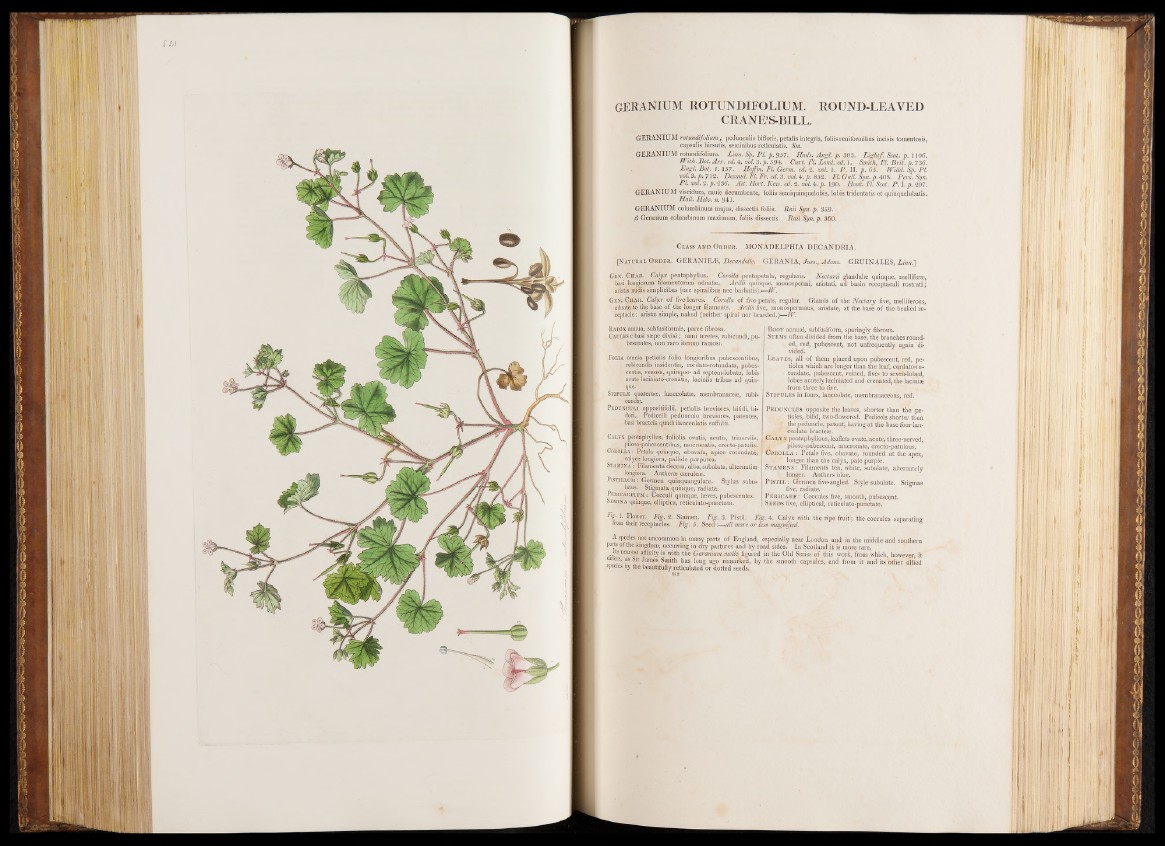
GERANIUM ROTUNDIFOLIUM. ROUND-LEAVED
CRANE’S-BILL.
GERANIUM rotundifolium ; pcdunculis bifloris, petalis integris, foliis reniformibus incisis tomentosis,
capsulis hirsutis, seminibus reticulatis. Sm.
GERANIUM rotundifolium. Linn. Sp. PI. p. 957. Huds. Angl. p. 303. Light/. Scot. p. 1106.
With. Bot. Arr. ed. 4. ml. 3. p. 594. Curt. FI. Bond. ed. 1. Smith, FI. Brit. p. 73.6.
Engl. Bot. t. 157. Hqffm. FI. Germ. ed. 2. ml. 1. P. II. p. 65. Willd. Sp. PI.
ml. 3. p . 712. Decand. FI. F r. ed. 3. ml. 4. p . 852. Fl.G a ll.S yn .pA0 3 . Pers.Syn.
P i. ml. 2. p. 236. Ait. Hort. Kew. ed. 2. ml. 4. p . 190. Hook. FI. Scot. P . I. p. 207.
GERANIUM viscidum, caule decumbente, foliis semiquinquelobis, lobis tridentatis et quinquelobatis.
Hall. Helv. rt. 941.
GERANIUM columbinum majus, dissectis foliis. Raii Syn.p. 359.
(3 Geranium columbinum maximum, foliis dissectis. RaiiSyn. p . 360.
Class a nd O rder. MONADELPHIA DECANDRIA.
[Natural Order. GERANIEJL, Decandolle. GERANIA, Juss., Adam. GRUINALES, Linn.]
Gen. Char. Calyx pentaphyllus. Corolla pentapetala, regularis. Nectarii glandulas quinque, melliferte,
basi longiorum filamentorum adnatae. Arilli quinque, monospermi, aristati, ad basin receptaculi rostrati;
aristis nudis simplicibus (nec spiralibus nec barbatis).—W .
Gen. Char. Calyx of five leaves: Corolla of five petals, regular. Glands of the Nectary five, melliferous,
adnate to the base of the longer filaments. Arills five, monospermous, aristate, at the base of the beaked receptacle
: aristas simple, naked (neither spiral nor bearded.)—IV.
Radix annua, subfusiformis, parce fibrosa.
Caules e basi sæpe divisi ; rami teretes, rubicundi, pu-
bescentes, non raro itenim ramosi.
Folia omnia petiolis folio longioribus pubescentibus,
rubicundis insidentia, cordato-rotundata, pubes-
centia, venosa, quinque- ad septem-lobata, lobis
acute iaciniató-crenatis, laciniis tribus ad quin-
que^- ■
STIPULÆ quaternæ, lanceolatæ, membranaceæ, rubi-
cundæ.
Pedunculi oppositifolii, petiolis breviores, bifidi, bi-
flori. Pedicelli pedunculo breviores, patentes,
■nasi bracteis.quadrilanceolatis suffulti.
Calyx pen&phyllus, foliolis ovatis, acutis, trinerviis,
pilosQ|pubescèntibus, mucronatis, erecto-patulis.
Corolla : Petala quinque, obovata, apice rotundata,
calyce lougiora, pallide purpuréa.
Stamina : Filamenta decem, alba,subulata, alternatim
longiôra. Antheras cæruleæ.
PlSTlLLUM: Germen quinquangulare. Stylus subu-
latus.; Stigmata quinque, radiata.
Pericârpium : Cocciili quinque, læves, pubescentes.
Semina quinque, elliptica, reüculato-punctata.
Root annual, subfusiform, sparingly fibrous.
Stems often divided from the base, the branches rounded,
red, pubescent, not unfrequently again divided.
Leaves, all of them placed upon pubescent, red, petioles
which are longer than the leaf, cordato-ro-
■ tundate, pubescent, veined, five- to seven-lobed,
lobes acutely laciniated and crenated, the lacinias
s from three to five.
Stipu l e s in fours, lanceolate, membranaceous, red.
Peduncles opposite the leaves, shorter than the petioles,
bifid, two-flowered. Pedicels shorter than
/ ,_the peduncle, patent, having at the base four lan-
i'j" ceolate bracteas.
Calyx pentaphyllous, leaflets ovate, acute, three-nerved,
^ piloso-pubescent, mucronate, erecto-patulous.
Corolla : Petals five, obovate, rounded at the apex,
I- longer than the calyx, pale purple.
Stamens : Filaments ten, white, subulate, alternately
\\ .longer. Anthers blue.
Pis t il : Germen five-angled. Style subulate. Stigmas
five, radiate.
P e r ica rp : Coccules five, smooth, pubescent.
Seeds five, elliptical, reticulato-punctate.
f 1?wer- Fig. 2. Sta'inen. Fig. 3. Pistil. Fig A . Calyx with the ripe fruit; the coccules separating
trom their receptacles. i%'. 5. Seed :—-all more or less magnified.
A species not uncommon in many parts of England, especially near London and in the middle and southern
parts of the kingdom, occurring in dry pastures and by road sides. In Scotland it is more rare.
Its nearest affinity is with the Geranium molle figured in the Old Series of this work, from which, however, it
i era,-as Sir James Smith has. long ago remarked, by the smooth capsules, and from it and its other allied
species by the beautifully reticulated or dotted seeds.